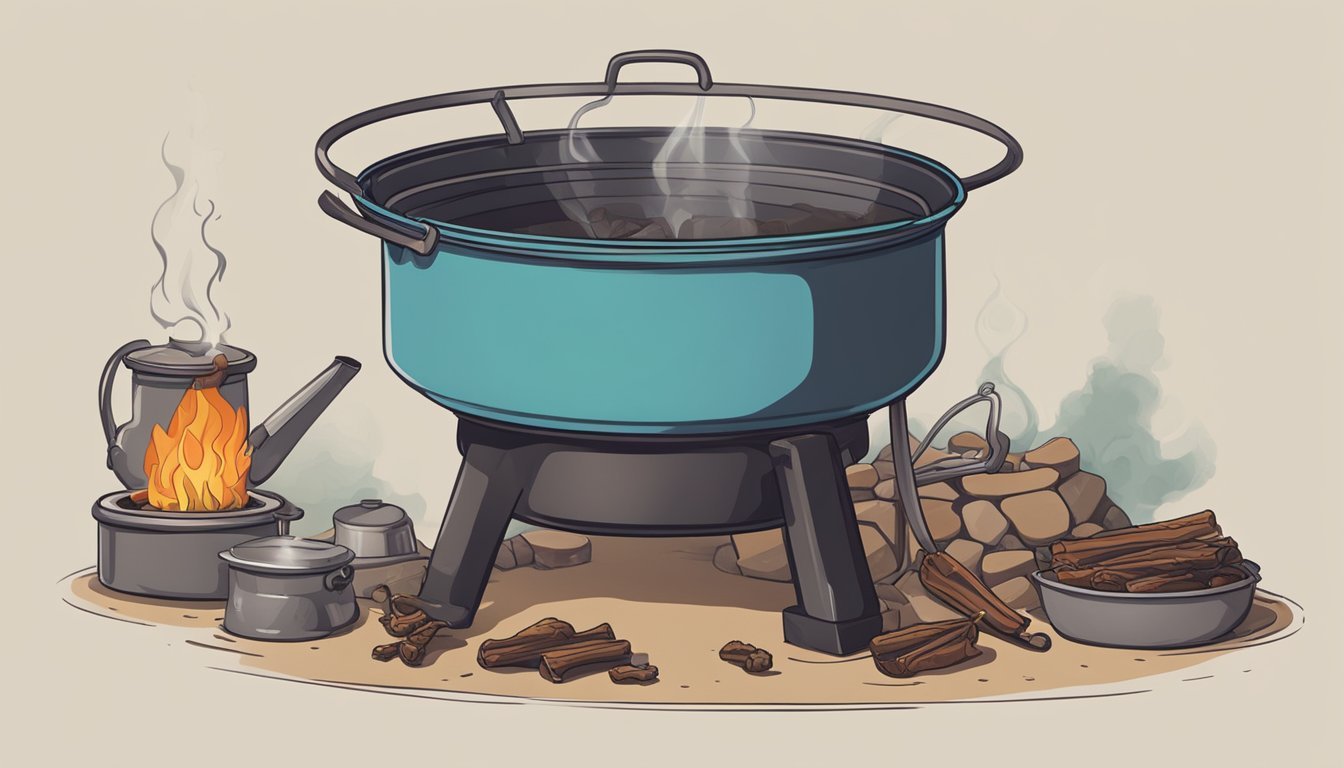The Ultimate Guide to Making Beef Bone Char for Efficient Water Filtration
Beef (What wine goes well with beef?) bone char has been recognized as an effective material for filtering and purifying drinking water. The process of creating this char involves the thermal decomposition of animal bones, specifically from beef, in a low-oxygen environment. This treatment transforms the bone material into a highly porous char that is adept at adsorbing contaminants such as heavy metals, fluoride, and other impurities from water, making it significantly safer for consumption.
Utilizing beef bone char in water filters is a sustainable method that leverages by-products from the meat industry to address environmental concerns. Through the activation process, beef bone char acquires a vast surface area which enhances its filtration capacity. As an integral part of a water filtration system, beef bone char contributes to the multi-barrier approach, ensuring that drinking water meets safety standards and is of high quality.
The inclusion of beef bone char in domestic and community-level water purification systems underscores a low-cost yet highly efficient method of securing safe drinking water. The adaptability of beef bone char filters and the simplicity of the technology involved make it an accessible option for various applications, from individual households to larger communities, thereby underscoring its role in contemporary water treatment solutions.
Understanding Beef Bone Char
Beef bone char is a specialized form of carbon used for filtration, with unique properties and benefits. This section explores the core aspects of beef bone char, including its definition, how it compares to other char materials, and the advantages it offers.
Definition and Composition
Beef bone char is produced by heating cattle bones to high temperatures in an environment with low oxygen, a process known as pyrolysis. This method preserves the carbon structure and transforms the organic material into char. The primary components of beef bone char are carbon and calcium phosphate, the latter of which is in the form of hydroxyapatite. These materials imbue bone char with a considerable surface area and a porous structure, ideal for adsorbing impurities.
Comparison to Other Char Materials
When compared to other char materials like coconut shell or wood char, beef bone char exhibits a higher degree of microporosity, which contributes to its superior performance in water filtration. The surface area of bone char ranges between 200-400 m²/g, which is significantly higher than that of most wood chars. Additionally, the presence of calcium carbonate helps in the removal of certain contaminants more effectively than other char materials.
Benefits of Using Beef Bone Char
The porous nature of beef bone char, along with its composition, makes it particularly effective for filtering water. It not only adsorbs organic compounds but also helps in the removal of heavy metals, thanks to its calcium phosphate content. Moreover, beef bone char is capable of adjusting the pH of acidic water, increasing the water's alkalinity due to the release of calcium carbonate. These properties make beef bone char an excellent choice for water filtration systems, providing a natural and efficient method to purify water.
The Science of Water Filtration
Water filtration is an essential process for ensuring safe drinking water, removing various contaminants through mechanisms such as adsorption. Understanding the scientific principles that govern these processes is crucial.
Contaminant Removal Mechanisms
Contaminants in water include metals, fluoride, bacteria, and viruses. The removal of these compounds is achieved through different mechanisms. Metals and fluoride can be effectively eliminated via sorption, a process that encompasses both adsorption and absorption, where contaminants either adhere to a surface or are taken up into the bulk of the material. Microbial contaminants like bacteria and viruses, on the other hand, are typically removed by being physically blocked by a filtration medium or destroyed by disinfection methods.
The Role of Adsorption in Filtration
Adsorption plays a pivotal role in water filtration. It refers to the process in which contaminants adhere to the surface of a filter material. Bone char, produced from animal bones, is known for its adsorptive properties. The material's porous structure provides a large surface area that traps pollutants through chemical bonds.
Fluoride Removal: Bone char is particularly efficient at removing fluoride due to its high calcium content, making it one of the superior choices for areas with fluoridated water supplies.
Heavy Metals: It also captures heavy metals, such as lead and arsenic, preventing them from being present in filtered water.
Understanding Porosity and Surface Area
The effectiveness of bone char or any filter material largely depends on two physical characteristics: porosity and surface area.
Porosity: This refers to the volume of pores or voids within the material relative to its overall volume. High porosity means more space for water to flow through and for contaminants to be captured.
Surface Area: The amount of surface exposed to the water influences the number of contaminants that can be adsorbed. A greater surface area means there are more active sites for contamination to bind to, enhancing the filtrate's purity.
Bone Char: As a filtration material, bone char provides a high surface area due to its inherent porous nature, making it an efficient medium for water filtration applications.
In conclusion, the scientific concepts behind water filtration, particularly the process's reliance on adsorption, porosity, and surface area, are central to its effectiveness in removing contaminants from water.
Sourcing and Preparing Bones
In creating beef bone char for water filtration, selecting the right type of bones and accurately preparing them are crucial steps for effective results.
Types of Bones Best Suited for Char
Beef bones are the most common choice for making bone char, largely because of their density and size, which provide an ample surface area for adsorption once charred. Marrow bones and knuckle bones are particularly effective due to their high mineral content and structural integrity which remains even after the charring process.
Cleaning and Preparation Process
The cleaning and preparation process is vital to ensure the purity of the bone char. It involves thoroughly rinsing the bones to remove any residual meat, fat, or marrow. This is followed by a boiling step to further clean and sanitize the bones. It is essential to boil the bones for approximately an hour, changing the water frequently to remove impurities. Once boiled, the bones should then be dried completely, often using an oven at a low temperature to achieve consistent dryness throughout the bones. When the bones are dry and free from organic material, they are ready to be charred for water filtering purposes.
Production of Beef Bone Char
The production of beef bone char is a precise operation that requires controlled conditions for optimal results. The char can notably remove impurities from water, serving as a means of filtration.
Charring Process Overview
In the process of making beef bone char, animal bones undergo a high-heat treatment in an environment deprived of oxygen—a method known as pyrolysis. Initially, bones are cleaned and subjected to a thermal process to remove any remaining organic matter. Pyrolysis then ensues, transforming the bones into a rich carbon residue with an expansive surface area, ideal for adsorption of contaminants from water.
Kilns and Gasifiers
Kilns are traditional structures used for creating bone char. They are typically constructed of refractory materials capable of withstanding high temperatures, ensuring even heat distribution. As an alternative, gasifiers convert biomass into carbon through gasification, a process where bone material and a controlled amount of oxygen react at high temperatures. Gasifiers are efficient and have gained popularity due to their ability to process varying types of biomass alongside bone.
Optimizing Temperature and Time
For beef bone char production, temperatures typically range between 500°C to 700°C. Sustaining this temperature for several hours ensures all volatile compounds are eliminated, and a stable form of carbon remains. Here is a summary of optimal conditions:
Factor Optimal Condition Temperature 500°C - 700°C Duration 4 - 8 hours Environment Oxygen-depleted
Adhering to these specific conditions yields beef bone char with high purity and adsorption capacity, making it a reliable medium for water filtering purposes.
Optimizing Bone Char for Water Filtration
To enhance water purification, bone char's effectiveness hinges on its preparation and usage methods. Specific techniques in the creation and maintenance phases can maximize its pollutant removal capabilities
Filtering Common Contaminants
When making beef bone char for filtering water, it is crucial to understand its effectiveness against various contaminants. Beef bone char has proven efficient in removing specific pollutants from water, offering a cleaner and safer consumption experience.
Removing Heavy Metals and Fluoride
Beef bone char is particularly adept at adsorbing heavy metals such as lead, as well as fluoride from contaminated water. The porous structure of the char binds these metals effectively, reducing their presence significantly. For example:
Lead: Reduction levels can reach 2-4% for lead ions, showcasing strong interaction with bone char.
Fluoride: Removal efficiency is notably high, with some instances reporting up to 90% elimination.
Eliminating Chlorine, Pesticides, and Herbicides
The carbonized bone material is also efficient in addressing other common water contaminants like chlorine, pesticides, and herbicides present in water supplies.
Chlorine: Not only does it adsorb chlorine, but also it considerably improves the taste and odor of the treated water.
Pesticides and Herbicides: The adsorptive capacity extends to these agricultural chemicals, which often seep into water systems.
Dealing with Organic and Inorganic Compounds
The application of bone char is not limited to the aforementioned contaminants. It also interacts with a variety of organic and inorganic compounds.
Organic Compounds: Bone char can trap a range of organic pollutants, some of which include remnants from industrial waste.
Inorganic Compounds: The treatment process can also immobilize inorganic substances, contributing to a decrease in overall water toxicity.
Practical Applications of Bone Char Filters
Bone char filters have demonstrated efficacy in removing pollutants like fluoride and heavy metals from water, making them useful across various sectors. They are integrated into water treatment systems for domestic, agricultural, and industrial purposes to enhance water quality and safety.
Home Water Treatment Systems
In the domestic sphere, bone char filters are frequently employed in home water treatment systems to ensure the potability of water. These systems involve the use of bone char to reduce fluoride levels by up to 90% and remove other contaminants including chlorine. They can be easily incorporated into under-sink units or whole-house water treatment systems.
Agricultural Water Treatment
For the agricultural sector, bone char filters serve an important role in water treatment processes to safeguard crops and ensure healthy growth. The application of bone char in agriculture extends to the purification of irrigation water, which potentially carries metals and other pollutants that could affect crop quality and yield.
Industrial Water Treatment
In industry, water treatment is crucial to maintain the quality of the product and the integrity of equipment. Bone char filters are utilized in various industrial water treatment systems to remove contaminants that can cause scaling and corrosion. They are especially valuable in industries where high-purity water is required, like in food and beverage processing or pharmaceuticals.
Health and Environmental Impact
The utilization of beef bone char in water filtration implicates notable health benefits alongside conscientious environmental stewardship. This section explores the correlation between bone char filtration, human welfare, community dynamics, and regulatory compliance.
Safe Drinking Water and Well-Being
Access to safe drinking water is critical for human health and well-being. Beef bone char serves as an efficient medium for removing contaminants such as heavy metals and fluoride from water. Pores within the char adsorb toxins, reducing health risks and ensuring water meets safety standards conducive to well-being.
Impact on Communities and Agriculture
The application of bone char for water treatment has a profound effect on communities. Clear, potable water bolsters community health and reduces the prevalence of waterborne diseases. In agriculture, treated water is vital for crop irrigation, ensuring food safety and supporting the livelihood of farmers by producing healthier, uncontaminated produce.
Environmental Protection Agency Standards
The Environmental Protection Agency (EPA) sets rigorous standards for water quality to protect public health. Bone char filtration aids in meeting these standards by effectively purifying water, thereby safeguarding the environment and enabling water sources to comply with EPA guidelines. Ensuring the filtration process aligns with these standards is crucial for maintaining ecological balance and public trust.
Maintenance and Safety Considerations
In the realm of bone char water filtration, consistent maintenance and strict adherence to safety protocols are paramount. Ensuring the longevity of the filtration system while safeguarding one's health demands attention to detail and regular water quality assessments.
Maintaining Bone Char Filtration Systems
Proper maintenance is crucial to the continued effectiveness of bone char filtration systems. These systems should be checked periodically for any signs of clogging or saturation, which can reduce their ability to filter contaminants effectively. It is recommended to:
Replace bone char media: Typically, every 6 to 12 months, or after filtering approximately 10,000 gallons of water, depending on usage.
Clean system components: Regular sanitization of the filter housing and replacement of seals or gaskets to prevent leaks and maintain hygiene.
Handling and Safety Protocols
When dealing with bone char, one should exercise caution to avoid ingestion or inhalation of the material. Safety protocols include:
Wearing protective gear: Gloves and masks should be worn to minimize direct contact and prevent inhalation of fine particles.
Proper storage: Bone char should be kept in a dry, sealed container away from food items to avoid contamination.
Water Testing and Quality Assurance
Regular testing is essential to ensure the filtered water meets safety standards. Water tests should focus on:
Contaminant levels: Conduct tests for common contaminants like fluoride, heavy metals, and chlorine, to ensure they fall below accepted thresholds.
Contaminant Testing Frequency Desired Limit Fluoride Every 3 months < 0.7 ppm Heavy Metals Biannual Per EPA standards Chlorine Every 3 months < 4.0 ppm
Overall water quality: Assess pH, taste, and odor regularly to detect any changes that might indicate the need for system maintenance or media replacement.







